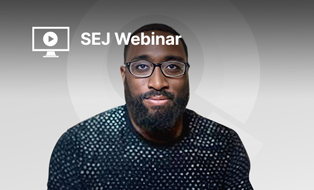After speaking internationally for almost 20 years and reviewing professional presentations for speakers of all levels, from Search Engine Journal webinars to helping out my colleagues, I’ve developed a deep understanding of what makes presentations truly resonate.
Through this journey, I’ve studied how people receive information and connect with speakers, and ultimately, how influence works in these settings.
When I first started reviewing presentations and giving feedback, it was just some quick ideas I would share based on my own speaking experience.
But, as more speakers began reporting positive results and requesting my input, I realized my approach was genuinely helping others elevate their presentations.
That evolution led to me conducting all the dry runs for the presenters for Search Engine Journal webinars, something I take great pride in today.

As someone who has been immersed in speaker prep and presentation dynamics for years, I’ve observed patterns in what makes audiences lean in versus tune out.
I’ve really focused on what makes presentations work and why people want to hear the psychology of it all.
These insights aren’t just theoretical; they’ve been battle-tested across continents, industries, and presentation formats.
Let me share some of the most valuable lessons I’ve learned about creating presentations that not only inform but also truly connect with your audience.
Master The Art Of Storytelling And Authenticity
People don’t connect with slide decks; they connect with stories and authentic experiences.
Your presentation needs a narrative backbone.
As Jennifer Aaker, professor at the Stanford Graduate School of Business, notes, “Stories are remembered up to 22 times more than facts alone.”
This is backed by research showing that after a presentation, 63% of attendees remembered stories, while only 5% remembered statistics.
When you get in here, people are going to be a little apprehensive about being sold something. They always are. And also, people get distracted easily.
So, there is a sort of attention span, a sort of “how do I feel about you?” that works itself out throughout the presentation.
The most effective approach follows a three-part formula:
- First, identify the problem that resonates with your audience. Everybody’s coming in because they have a problem. Make it painful and relatable: This problem is painful. You feel this problem sucks for you.
- Second, establish that you’ve walked in their shoes: You connect that you also have this problem. You put yourself in the same space. You bring yourself to the same level as them.
- Third, position your insights as the solution: I found a solution by spending an enormous amount of time and energy and work doing only this, because this is how crazy I am. This is just what it is.
Talk like you’re sharing insights with a friend at a bar who asked about your area of expertise. This conversational approach feels authentic rather than rehearsed.
Rethink Your Approach To Slides
Your presentation is for you, not for them. Slides should serve as visual anchors for your natural thought process, not as reading material for the audience.
For me, every slide has only one core required talking point. I could talk about more, but there’s only one that’s required before I can go to the next slide. So, if I ever lose my train of thought, all I have to do is go to the next slide and reset.
Here’s a powerful exercise I recommend: Build out your presentation and talk through it, then set it aside and have that same conversation without any slides. Your mental dialogue is your authentic story.
When you notice there’s a disconnection between your natural flow and your slide arrangement, adjust the slides, not your thinking.
If you find yourself jumping to slide seven when you should be on slide two, you don’t change your mind; you change the slides because your internal story is your authenticity.
This approach ensures that even if you get lost or distracted, as soon as you go to the next slide, you’ll immediately reconnect with your narrative flow.
Master The Psychology Of Audience Connection
Understanding psychological triggers that create a connection is essential for presentations that truly resonate.
People don’t need the right answer. They need to feel that they resonate with the answer they hear and that they came to it on their own.
So, you’re kind of giving them enough of a feeling that they’re in a mutual resolution step.
This creates a powerful dynamic: By putting them in that state, they become your friend and they believe in you.
People naturally want to share decision-making because it distributes responsibility. It’s hardwired into our survival instincts.
When painting problem scenarios, elaborate enough that everyone finds at least one element that resonates with their situation.
You can rattle off a list of problems so that each one of those problems resonates with somebody. By highlighting various issues, each person will find something that speaks to them.
This technique means everybody’s got an “OK, this relates to me” moment and they start solving their own problems through your guidance.
Strategic Engagement Through Pacing And Pauses
One often overlooked aspect of great presentations is giving audiences time to process information mentally.
People can’t process until you stop talking. They need a moment to process with their own audio, like their own internal dialogue.
Incorporate deliberate pauses after key points with simple phrases like:
- Just think about that for a second.
- Just absorb that for a second, and then let’s keep going.
- Let’s wrap your head around that for a second.
Even microsecond pauses allow people to connect the dots and make the neurological connections they need to.
Without these processing moments, you’ll observe a classic case of “information overload,” where retention plummets regardless of content quality.
When speakers continuously deliver information without breaks, the audience simply can’t absorb what’s being shared, no matter how valuable it might be.
Expertly Navigate Transitions Between Topics
People come in and out of attention during presentations, so your storytelling needs to be consistent across all slides.
Every single time you shift the topic, remind them of where we just came from and where we are going in the journey. This makes everybody feel like they’re going along, like a tour guide.
Create these connective transitions with phrases like:
- Well, now that we’ve got the setup done, in order to get us to the point where we can see the return on investment (ROI), we want to go and do this next, right?
- Now that we’ve seen that side, let’s check out where they slept.
You’re essentially guiding people through a tour of your ideas, constantly reorienting them to maintain engagement regardless of attention fluctuations.
Time Management And Content Prioritization
Knowing yourself as a presenter is crucial for effective time management.
I would plan to have about 20 minutes for Q&A. And in order to do that, you want your presentation to be about 25 to 30 minutes.
It’s helpful to run through it, practice it, and know yourself. Do you talk fast when you’re actually doing it live? Do you digress and give a lot of extra examples? And it ends up going longer.
Remember that every minute you kind of go past is just a minute that’s taken away from Q&A. When prioritizing content, it’s better to go deeper on fewer topics than to rush through many.
If you have 10 things to share and you scale it down to four, but tell those four things in three different ways so that everybody can resonate with them and feel like they really mean something to them, they’ll walk away with more than if you just gave them 10 things that they can’t connect with.
Effectively Using Polls For Reengagement
I am not a fan of polls personally, but they do serve a crucial reengagement function during presentations.
What we look at polls for is a reconnection of the eyes on the screen. People get distracted, and they end up talking to colleagues and stuff. And when there’s a poll, it’s like, “Oh, I need to come and participate.”
Strategic poll placement matters: If you put them at the beginning, then you’re reconnecting them when they’re already reconnected, which is fine. But for that purpose, you’d want it a little bit later on, in the middle or something.
Polls can also segment your audience for targeted follow-up: Being able to identify pain points where you can adjust the wording when you send your emails afterwards and you reach out.
Technical Preparation For Seamless Delivery
Technical hiccups can derail even the best content, so preparation is essential.
Jump in about 10-15 minutes before and just do a tech check for basic stuff, like rebooting the system real quick. If you have a Cat cable, run it because it’s more stable. Little things like closing out programs would also help.
Having backup options is crucial: Having a PDF is a great way. You can still break off and go live if you want. Same thing with sharing your screen.
This preparedness ensures you can navigate potential technical challenges without losing momentum.
The Final Word On Presentation Excellence
Throughout my career, speaking around the world, I’ve found that the most impactful presentations blend technical skill with authentic human connection.
Whether you’re presenting to five people or 5,000, these principles hold true.
One speaker recently shared their experience, which reinforced my passion to keep sharing my speaking experience and thoughts: “Your presentation advice has been invaluable, Brent. You have this remarkable talent for making complex communication principles feel intuitive and actionable.
Since implementing your storytelling techniques and engagement strategies, I’ve felt more confident and authentic on stage, and my audiences are clearly more responsive. You’ve helped me transform from simply delivering content to creating genuine connections. Thank you for being such an insightful presentation partner.”
Remember that your audience isn’t looking for perfection; they’re looking for value delivered in a way that respects their time and intelligence.
As I often tell speakers I’m coaching: Nobody’s looking to break you. They’re genuinely there because they are trying to learn.
By consistently implementing these strategies, you’ll transform from simply presenting information to creating memorable experiences that drive real action and change. And ultimately, isn’t that what great speaking is all about?
More Resources:
- 5 Ways To Improve Your Public Speaking Skills
- How To Get Buy-In From Stakeholders Using Overlooked Soft Skills
- State Of SEO 2025
Featured Image: Anton Vierietin/Shutterstock





![AI Overviews: We Reverse-Engineered Them So You Don't Have To [+ What You Need To Do Next]](https://www.searchenginejournal.com/wp-content/uploads/2025/04/sidebar1x-455.png)